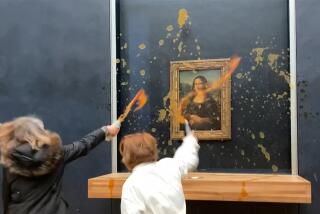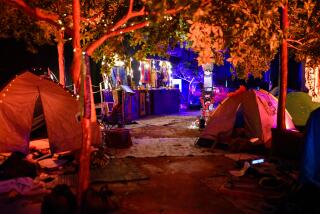Online, images of defiance to terrorism
The images would be right at home on a refrigerator or a dorm-room wall: smiling babies, suburban families posing in bathing suits, friendly dogs. A few are more whimsical or show a cheeky use of graphic design.
But these pictures, some taken with cellphones, some bearing slogans asserting their fearlessness, have a serious aim: to tell the world that their makers are not intimidated by the terrorist attacks in London, Egypt, New York City and elsewhere.
The images come from a website whose title -- www.werenotafraid.com -- makes its point pretty clearly, however approximate the punctuation. With 7,500 images posted and more than 20,000 being processed, the site has become a sensation: Last week, it topped 5 million visitors, and it now sells T-shirts whose earnings will help fund the site (a nonprofit company) and assist Red Cross and other charitable efforts.
“The message is simple, but it’s also powerful,” says Amanda Timpson, a Los Angeles-based staffer for Werenotafraid.com, which is run by volunteers living all over the world. “We want to raise global awareness and bring together community that says, ‘We are not afraid of this, we will not respond to terror and aggression in kind, that’s not how we will live our lives.’ ”
The site started when 29-year-old London Web designer Alfie Dennen received a photo through his cellphone from a friend who was evacuating an Underground tunnel after the July 7 bombings, and wanted to reassure friends and family that he was safe.
Dennen put that image, and others he received, onto a website. As they were seen by more and more people, other images began streaming in: Some were from the New York area, from people who had lived through the Sept. 11 attacks; eventually, others began to come from around the world.
“About three hours after Alfie put up the first photo,” Timpson says, “it was already about the rest of the world, and about a much larger message.”
The site now has volunteers in Europe, the States and Australia, and contributions have come from places as far-flung as Korea, South Africa and Norway. (Submissions are reviewed before posting, Timpson says, to screen out “vulgarity and aggression.”)
“Projects like this are part soapbox, part backyard fence, part confessional,” says Walter Robinson, editor of www.artnet.com, a Web-based art magazine. “The idea is that people can reach out to each other for consolation and courage, for humor and help.” It also shows a change in society. “We used to reach out to a small circle of friends, but now because of digital technology, our reach extends far and wide,” Robinson says.
The connection between terrorism and a mass public response is quite natural, says Benjamin Bratton, a sociologist visiting in UCLA’s department of design/media arts. Terrorism is a diffuse war that doesn’t recognize the difference between a battlefield and a civilian space, he says, so the public reaction is often equally widespread.
“People are responding as if the attacks had happened to them,” he says. “There’s a need to respond to the acts as if they’ve been perpetrated on everyone. They realize they could have been that person. And the Web has, for better or worse, taken on the role of the public square, where people come together and speak with a kind of collective voice.
“That’s why a site like Werenotafraid makes sense, because people realize that those who were killed [in London] were standing in for anybody and everybody: It’s diffuse and generalized.”
These Web responses are not without precedent, says Robinson. He points out that the video and conceptual artist Les Levine did a series of New York subway posters and billboard pieces with the slogan “We Are Not Afraid” in about 1980, at a time of high tensions about subway and street crime in the city.
Says Bratton: “These forms of communication ... take on what a film theorist would call ‘genre formalism.’ What seem to be these spontaneous outpourings of collective sentiment are, in fact, highly formatted. There already is a system in place, a structure in place.”
Of course, all kinds of Web images have been disseminated since the London bombings. One is a shot of a London Underground message board that says: “Please do not run on the platforms or concourses. Especially if you are carrying a rucksack, wearing a big coat, or look a bit foreign. This notice is for your own safety. Thank you.”
Timpson says the Werenot afraid images have gotten more elaborate. “Originally it was just pictures, but now people are composing music for us, writing poems, creating videos,” which range from light and playful to emotionally haunting.
“Everybody has their own way to say, ‘I’m not afraid and here’s how I’m going to tell the world.’ ”
Robinson of Artnet.com admits he’s not entirely comfortable with the site. “The problem with this site is that there’s plenty to be afraid about -- it’s a little like whistling in the dark. There are dangers out there, and too much of this ‘We are not afraid’ stuff sounds like empty bravado. It echoes President Bush’s inane ‘Bring it on’ quote, for which he’s been much criticized.”
Timpson says the site isn’t about people shaking their fists, but rather summoning the strength and courage to fight off fear. “Personally, I lost a friend in the 9/11 attacks, so I’m very familiar with that feeling. But being fearless is about saying, ‘I’m not going to change the way I live my life.’ ”
She also thinks that the site’s defiant spirit will continue, even if attacks like those in London and Egypt fall off. “I think there’s been a subtle shift in the world community because of the escalation of these attacks,” she says.
“And I think people are tired of it and ready to come together to find a solution. I hope there are no more public attacks in the next six months, year, ever. But I don’t think that will affect the momentum of this movement.”
More to Read
Sign up for Essential California
The most important California stories and recommendations in your inbox every morning.
You may occasionally receive promotional content from the Los Angeles Times.










